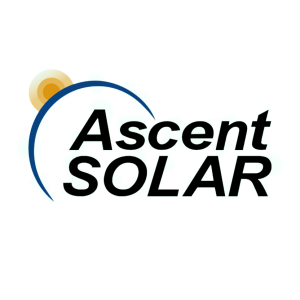NASA’s Marshall Space Flight Center Selects Ascent Solar Technologies CIGS Modules for Their LISA-T and Solar Cruiser Flight Experiments
Ascent Solar Technologies (OTCQB: ASTI) has been selected by NASA's Marshall Space Flight Center for participation in two significant flight demonstrations: the LISA-T project and the Solar Cruiser solar sail project. These initiatives aim to utilize Ascent's lightweight, flexible CIGS photovoltaic technology for various space missions, including CubeSats and future lunar and Martian explorations. Both projects will showcase the performance of Ascent's PV technology in space, potentially revolutionizing power generation for small spacecraft.
- Selected by NASA for two critical projects, enhancing credibility.
- Participation in LISA-T and Solar Cruiser positions Ascent as a key player in the space-grade PV market.
- Previous successful testing of CIGS technology aboard the International Space Station.
- None.
THORNTON, CO, March 01, 2021 (GLOBE NEWSWIRE) -- via NewMediaWire – Ascent Solar Technologies, Inc. (OTCQB: ASTI), a developer and manufacturer of state-of-the-art, lightweight and flexible thin-film photovoltaic (PV) solutions (“Ascent” or the “Company”), announces that the Company has been selected by NASA's Marshall Space Flight Center in Huntsville, Alabama, for participation in two upcoming flight demonstrations – the Lightweight Integrated Solar Array and anTenna (LISA-T) project and the Solar Cruiser solar sail project.
Ascent’s flexible, ultra-lightweight, monolithically-integrated photovoltaics (PV) are based on the copper-indium-gallium-selenium (CIGS) chemistry and could benefit various future missions, ranging from CubeSats, solar sails, and potentially for missions to the moon and Mars. In order to obtain the necessary data to determine how flexible CIGS performs in the space environment, Ascent’s PV module has been undergoing extensive evaluation for years, including protracted and demanding ground simulation test and, most recently, as a part of the 10th Materials International Space Station Experiment (MISSE-X) flight experiment aboard the International Space Station that was launched on November 17, 2018 for a duration of over 1 year. The upcoming LISA-T demonstration, part of NASA’s Pathfinder Technology Demonstrator 4 CubeSat slated for launch in 2022, will also include Ascent’s flexible CIGS as part of its further photovoltaic experiment.
LISA-T is a fully thin-film, high-performing power generation and communications array for small spacecraft to solve the power limitation of today’s small satellites, which are becoming an attractive option for scientific, exploratory, and commercial interests. Utilizing an ultra-lightweight, easily stowable flexible array with integrated antenna elements, LISA-T will demonstrate a new approach using flexible PV that would solve the delicate weight and power issues. In addition, LISA-T would expedite the maturation of flexible PV technology that is much needed for space applications, and also provides a virtually identical PV array (minus the antenna) for the Solar Cruiser solar sail project. The Solar Cruiser mission will fly a small spacecraft with a large (>1,600 square meter) solar sail. Solar Cruiser will demonstrate the deployment of a large, high-performance solar sail, validation of all sail subsystems, controlled station-keeping, attitude control of the sail, demonstration of pointing performance for science imaging, and an increase in heliocentric inclination. Thus, power generation for both near-earth and deep space missions are being demonstrated by these two NASA efforts.
“We are honored that our involvement with NASA over the years is leading to flight opportunities for our product on both LISA-T and Solar Cruiser,” stated Dr. Joseph Armstrong, Chief Technology and Operating Officer of Ascent Solar. “Extensive ground testing and actual flight experience are pre-requisite to the acceptance by the space community. The experience we had with Marshall and NASA’s Space Technology Mission Directorate’s investments in development of LISA-T and MISSE-X flight experiments represented significant milestones for the Company, and will prepare our proprietary PV technology to be elevated to Technology Readiness Level 7 (TRL7) for future missions.”
“We are thrilled to be working with both the LISA-T and Solar Cruiser projects in transforming our lightweight CIGS PV into a space-grade product, a high-value PV market that we have been focusing on,” said Victor Lee, President and CEO of Ascent Solar. “Developing a PV module capable of integrating into a deployable array for CubeSats and future exploration missions was a first step with NASA, and now being slated as the PV supplier on Solar Cruiser separates Ascent from the competition and puts us in a very unique position in the industry to answer the mission-critical needs of these developing premium markets.”
ABOUT ASCENT SOLAR TECHNOLOGIES, INC:
Ascent Solar Technologies, Inc. is a developer of thin-film photovoltaic modules using flexible substrate materials that are more versatile and rugged than traditional solar panels. Ascent Solar modules were named as one of the top 100 technologies in both 2010 and 2015 by R&D Magazine, and one of TIME Magazine's 50 best inventions for 2011. The technology described above represents the cutting edge of flexible power and can be directly integrated into consumer products and off-grid applications, as well as other aerospace applications. Ascent Solar is headquartered in Thornton, Colorado, and more information can be found at www.AscentSolar.com.
Forward-Looking Statements
Statements in this press release that are not statements of historical or current fact constitute "forward-looking statements." Such forward-looking statements involve known and unknown risks, uncertainties and other unknown factors that could cause the Company's actual operating results to be materially different from any historical results or from any future results expressed or implied by such forward-looking statements. In addition to statements that explicitly describe these risks and uncertainties, readers are urged to consider statements that contain terms such as "believes," "belief," "expects," "expect," "intends," "intend," "anticipate," "anticipates," "plans," "plan," to be uncertain and forward-looking. The forward-looking statements contained herein are also subject generally to other risks and uncertainties that are described from time to time in the Company's filings with the Securities and Exchange Commission.
Ascent Solar Technologies
Investor Relations: IR@AscentSolar.com
FAQ
What projects will Ascent Solar Technologies participate in with NASA?
How does Ascent's technology benefit NASA's missions?
What is the significance of the LISA-T project for Ascent Solar?
When is the LISA-T project expected to launch?







